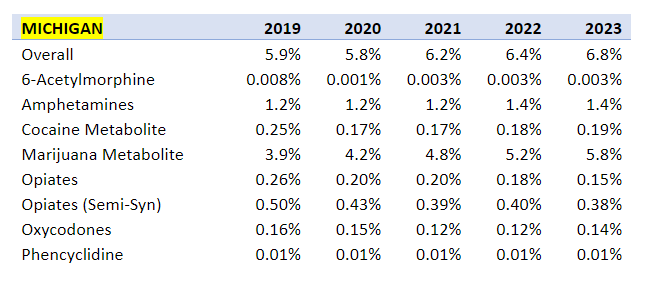
Workforce drug test tampering surged in 2023, small business advice on drug policies to consider
By onBusiness Practices
The percentage of employees in the general U.S. workforce whose drug tests showed signs of tampering increased by more than six-fold in 2023 compared to 2022 — the highest rate in more than 30 years of annual reporting, according to Quest Diagnostics.
The increasing rates of substituted or invalid specimens coincide with historically high rates of both general U.S. workforce drug positivity and post-accident marijuana positivity, a Quest news release states. Drug positivity in the general U.S. workforce was 5.7% in both 2022 and 2023.
Quest found an increase of 633% in substituted urine specimens by the general U.S. workforce, and invalid specimens increased 45.2%. Substituted or invalid specimens suggest tampering in an attempt to conceal drug use, according to Quest. Substituted specimen use in the federally mandated, safety-sensitive U.S. workforce group increased 370.6% and invalid rates increased 36.7%.
Repairer Driven News spoke with Suhash Harwani, Quest Diagnostics workforce health solutions senior director of science, who elaborated on how this can affect the small business workforce and SOPs, especially since marijuana impairment on the job has increased.
Harwani recommends collision shop owners review their drug use policies if medical marijuana use is legal in their state and consider using instant result drug tests on employees who have prescriptions. This will ensure that they aren’t impaired for their workday or if they are, that they won’t be working with heavy equipment, machinery, or anything that could compromise safety, he said.
Nearly 9.8 million workforce drug tests from last year were analyzed by Quest Diagnostics and the results were recently released.
Marijuana positivity in the general workforce increased 4.7%. Over five years, marijuana positivity has increased 45.2%, with 2023 reaching a new peak compared to 2019 (3.1% in 2019 versus 4.5% in 2023), Quest said.
In the federally mandated safety-sensitive workforce (positions such as pilots and truck drivers who are required to be tested under federal guidelines), marijuana positivity decreased nationally 3.1% year over year.
“You do definitely see higher percentages in the general U.S. workforce,” Harwani said. “To me, that speaks volumes… I don’t think there’s ever a one-size-fits-all [solution] because what company A does may not be what company B does.”
However, he added, knowing and understanding the drug test data may lead business owners to implement random drug testing.
“Drug testing is a deterrence mechanism and that’s what it’s designed to be, it’s not an impairment standard,” Harwani said. “You’re not going to remove use completely and there’s going to be some need for prescription medications by donors… Understanding how you properly craft that drug testing policy, I think, is a key step in trying to ensure you have a safer workforce.”
He also noted that behind every drug test specimen, there’s a person who may be going through life events that are contributing to their result.
“There’s a wellness piece. There’s life events that do happen on our journey from hire to retire that we have to be cognizant of for our employees… How do we help them through these scenarios? Because it is a wellness journey.”
Understanding obstacles employees face can also aid in retention, Harwani added.
“Most employers are highly focused on productivity, which can be achieved by improving workforce health and wellness,” he said. “A well-executed drug testing program can help an organization to maintain a healthier workforce which, based on our data, could decrease the potential for accidents or other unsafe behaviors.”
In 2023, post-accident marijuana positivity in the general U.S. workforce was 7.5%. The new peak follows a steady increase in post-accident marijuana positivity every year from 2015 to 2023, Quest found. In that nine-year timeframe, post-accident marijuana positivity increased 114.3%.
Marijuana positivity stayed the same (1.1% in both 2022 and 2023) in states where recreational marijuana is legal and decreased 2.2% (0.90% in 2022 versus 0.88% in 2023) in states where medical marijuana is legal, according to Quest’s findings.
In states where neither recreational nor medical marijuana use is legal, marijuana positivity decreased 6.7% (0.89% in 2022 versus 0.83% in 2023) year over year and stayed the same over five years (0.83% in 2019 versus 0.83% in 2023).
“Given the growing acceptance and use of some drugs, particularly marijuana, it may be unsurprising that some people feel it necessary to try and cheat a drug test,” Harwani said. “It is possible that our society’s normalization of drug use is fostering environments in which some employees feel it is acceptable to use such drugs without truly understanding the impact they have on workplace safety.
“The federally mandated, safety-sensitive population has a lower rate of drug positivity, likely due to the fact that there is decreased drug use when there is an expectation of being drug tested. This is fundamentally the strength of having a drug testing program. The mere expectation of drug testing may be a deterrent, dissuading individuals from both drug use and applying for positions where such tests are standard practice,”
Quest data aligns with other reports associating marijuana legalization with workplace harm. A February 2024 study in the Journal of the American Medical Association found recreational marijuana laws that allow recreational marijuana sales were associated with a 10% increase in workplace injuries among individuals aged 20-34 years.
“Organizations must have sound policy and procedures to ensure employee drug testing programs have efficacy,” said Katie Mueller, a senior program manager at the National Safety Council, in the release. “Cheating on drug tests not only undermines workplace safety but also jeopardizes the safety of society as a whole. Companies, regulators and policymakers must prioritize accountability for the well-being of all individuals in our communities; lives depend on it.
“As the prevalence of marijuana positives in the workforce rises, our concern grows. The data show an increasing correlation between marijuana use and adverse workplace effects, prompting a call for heightened vigilance and comprehensive strategies to safeguard workplace safety and productivity.”
In 2023, in the combined U.S. workforce, urine drug positivity for all drugs was 4.6% — the same as in 2021 and 2022, according to Quest. This overall positivity is the highest level in more than two decades, up more than 30% from an all-time low of 3.5% in 2010-2012, and coincides with a sharp increase of 114.3% in post-accident positivity between 2015 and 2023 in the general U.S. workforce.”
Michigan, where recreational and medicinal marijuana use is legal, saw the highest positivity at 5.8% compared to national positivity at 3.1%, 87.1% higher in the state.
Overall drug positivity in Michigan was 6.8% compared to 4.6% nationwide making the rate 47.8% higher at the state level.
Within the office worker population, those who complete administrative, managerial, and clerical tasks, marijuana positivity increased in 13 out of 15 industries led by finance and insurance which increased 35.7%.
“It isn’t clear why we’re seeing an increase in overall and marijuana drug positivity in office workers, but it isn’t a stretch that a combination of unprecedented stress and isolation during the pandemic with work-from-home policies during and post-pandemic may be contributing to greater drug use in employees in traditionally white-collar fields,” said Sam Sphar, Quest Diagnostics workforce health solutions vice president and general manager, in the release.
“The results underscore the growing need for mental health support and drug education programs to ensure employees are safe and productive, whether working at home or in the office.”
Test positivity among other drugs
Cocaine positivity in the general U.S. workforce increased 9.1%. Amphetamines remained flat (1.5% in 2022 and 2023) and 6-AM (heroin metabolite) decreased 16.7%.
Opiates codeine and morphine decreased 12.5% while opiates hydrocodone and hydromorphone decreased 9.4%. Oxycodone decreased 3.6%. Results show that all three drug categories continued a downward trend of test positivity over five years, according to Quest.
Images
Featured stock image credit: Hailshadow/iStock
Data charts provided by Quest Diagnostics
More information
Attorney: Independent contractors and marijuana users are HR concerns for 2024


